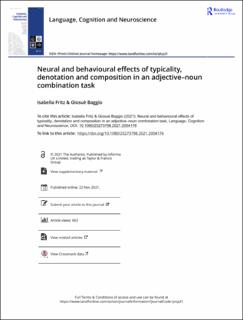| dc.contributor.author | Fritz, Isabella | |
| dc.contributor.author | Baggio, Giosuè | |
| dc.date.accessioned | 2022-11-29T07:43:20Z | |
| dc.date.available | 2022-11-29T07:43:20Z | |
| dc.date.created | 2021-11-29T10:57:52Z | |
| dc.date.issued | 2021 | |
| dc.identifier.citation | Language, Cognition and Neuroscience Volume 37, 2022 - Issue 5 Pages 537-559 | en_US |
| dc.identifier.issn | 2327-3798 | |
| dc.identifier.uri | https://hdl.handle.net/11250/3034621 | |
| dc.description.abstract | Formal semantics states that the meanings of phrases are composed from the meanings of constituent parts and syntax. Little is known about how composition is neurally implemented. We studied ERP and behavioural responses to determiner-adjective-noun phrases. We assessed the effects of typicality and denotation, using intersective (typical: “A green turtle”, atypical: “An orange turtle”) or subsective adjectives (typical: “A slow turtle”, atypical: “A fast turtle”). After each phrase, participants responded to two questions (e.g., for “A fast turtle”: “Is it a common turtle?”; “Is it a fast animal?”). We contrasted these 4 semantic conditions, requiring composition, to 2 nonsemantic conditions, where the adjective was replaced with a pseudoword or a nonword. This contrast revealed a larger P600, if participants performed the task without instructions and feedback (experiment 1), or a larger sustained negativity, if they were nudged to pay attention to meaning by instructions and feedback (experiment 2). Typicality or denotation had an impact only on behavioural responses. We discuss implications for theories of language processing and compositional semantics. | en_US |
| dc.language.iso | eng | en_US |
| dc.publisher | Taylor and Francis Group | en_US |
| dc.relation.uri | https://doi.org/10.1080/23273798.2021.2004176 | |
| dc.rights | Attribution-NonCommercial-NoDerivatives 4.0 Internasjonal | * |
| dc.rights.uri | http://creativecommons.org/licenses/by-nc-nd/4.0/deed.no | * |
| dc.title | Neural and behavioural effects of typicality, denotation and composition in an adjective–noun combination task | en_US |
| dc.title.alternative | Neural and behavioural effects of typicality, denotation and composition in an adjective–noun combination task | en_US |
| dc.type | Journal article | en_US |
| dc.type | Peer reviewed | en_US |
| dc.description.version | publishedVersion | en_US |
| dc.source.journal | Language, Cognition and Neuroscience | en_US |
| dc.identifier.doi | 10.1080/23273798.2021.2004176 | |
| dc.identifier.cristin | 1960704 | |
| dc.relation.project | Norges forskningsråd: 251219 | en_US |
| cristin.ispublished | true | |
| cristin.fulltext | original | |
| cristin.qualitycode | 1 | |

